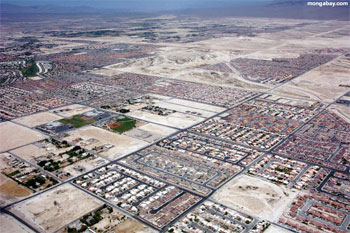Growth of cities can affect local weather
Growth of cities can affect local weather
Human activities in arid urban environments can affect rainfall and water cycle
University of Georgia
June 19, 2006
In the past half-century, cities have begun to expand in some of the Earth’s most arid areas. While scientists have known for some time that the so-called “heat-island” effect of large cities such as Atlanta and Houston can affect their weather, they knew less about this effect and other processes in arid cities, such as Phoenix, which have experienced explosive population growth.
Now, a study by a climatologist in the department of geography at the University of Georgia has shown, using a unique 108-year-old data record and NASA’s Tropical Rainfall Measuring Mission (TRMM) satellite, that arid cities such as Riyadh in Saudi Arabia and Phoenix have an effect on rainfall patterns around them. As important, it appears that human activities such as land use, aerosols and irrigation in these arid urban environments affect the entire water cycle as well.
“Many of the fastest-growing urban areas are in arid regimes,” said Marshall Shepherd, author of the report just published in the online edition of the Journal of Arid Environments. “Because their total rainfall is low, these areas have been largely ignored in studies on how human activities affect the water cycle. But these cities are particularly sensitive to such changes, since the water supply is so critical.”
The research was funded by the Precipitation Measurement Missions program of the U.S. National Aeronautics and Space Administration.
Cities in arid areas are excellent models for understanding human-induced changes in the water cycle. In most cases, the cities have shown great growth only in the last 30-50 years because of new methods of irrigation and ways to obtain water for daily use. In the case of Phoenix, Shepherd had access to a unique 108-year-old data record that covered pre-and post-urban times and for the first time confirmed that a statistically significant change in rainfall took place in certain areas of Phoenix from the late 1890s to the present.

Las Vegas |
The stakes in understanding how weather affects the water-cycle in all cities are enormous. By 2025, according to one United Nations estimate, 60 to 70 percent of all people will live in cities, and many of the fastest-growing areas for city growth are in arid areas.
One of the most interesting findings in the new study was a 12-14 percent increase (which scientists call an anomaly) in rainfall in the northeast suburbs of Phoenix from the pre-urban (1895-1949) to post-urban (1950-2003) periods. A previous study first noted the possible anomaly but focused only on the post-urban period, so it was not clear whether the change was tied to post-1950 urbanization around Phoenix. It is hypothesized that this anomaly is related to urban-topographic interactions and possibly irrigation moisture. Indeed, the role of irrigation in changing the weather of cities in arid areas is one of the more intriguing findings, and one that will bear more study.
“We think that these human activities can actually alter the natural system and interact with monsoon flow and mountain convection,” said Shepherd. The weather in Phoenix, in fact, is affected by both.
Riyadh has also shown significant grown in the past few decades, and its weather also has been affected by the heat-island affect. (The large surface of pavement and buildings actually increases the heat of a city area, and when that heat rises, it can change weather patterns in and near cities.) Precipitation patterns have changed in Riyadh as well, though the causes are less clear than in Phoenix. Ground data confirm a recent significant increase in rainfall around Riyadh.
Through use of rainfall records and information from the Landsat, Aster and TRMM satellites, Shepherd was able to demonstrate unusual patterns that clearly show how human activities are affecting the weather in arid regions. This study also illustrates how satellite data can be used to observe the changing landscape and climate in regions like the Middle East, where traditional measurements are sparse or inaccessible.
“The results showed us just how sensitive the water cycle can be to human-induced changes,” said Shepherd, “even under arid or drought conditions. These findings have real implications for water resource management, agricultural efficiency and urban planning.”
Indeed, weather and climate models for these areas must increasingly deal with patterns of urban land use, aerosols and irrigation if they are to help planners understand and predict these large-scale processes.
“It’s fair to say we don’t yet understand how all these variables work together to change the water cycle in these arid regions,” said Shepherd, “but these cities live and die by their water supplies, and we must begin to study these anomalies more and find out how they work.”
This article is a modified news release from the University of Georgia.













